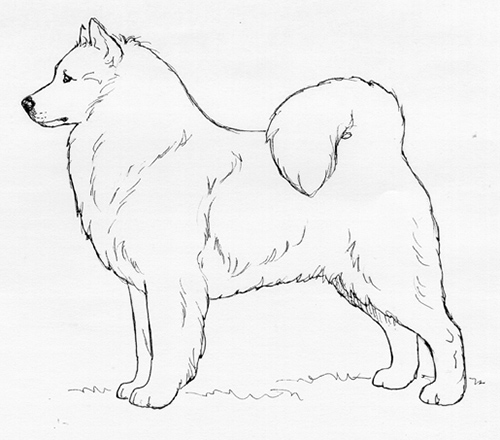Japanese Spitz
Northern Breed Group
The goals and purposes of this breed standard include: to furnish guidelines for breeders who wish to maintain the quality of their breed and to improve it; to advance this breed to a state of similarity throughout the world; and to act as a guide for judges.
Breeders and judges have the responsibility to avoid any conditions or exaggerations that are detrimental to the health, welfare, essence and soundness of this breed, and must take the responsibility to see that these are not perpetuated.
Any departure from the following should be considered a fault, and the seriousness with which the fault should be regarded should be in exact proportion to its degree and its effect upon the health and welfare of the dog and on the dog’s ability to perform its traditional work.
History
The Japanese Spitz is descended from the larger German Spitz dogs that were brought to Japan around 1920 via Siberia and northern China. In 1925, two pairs of white Spitz were imported from Canada, and for the next ten years more imports came from Canada, the U.S., Australia and China. The offspring of all these dogs were crossbred to create the breed that was recognized in 1948 as the Japanese Spitz.
The Japanese Spitz was recognized by the United Kennel Club in 2006.
General Appearance
The Japanese Spitz is an elegant, spirited and dignified breed that has prick ears, a high set tail that is carried curled over the back, and a sparkling white coat that stands off the body.
Characteristics
The breed is intelligent, cheerful and keen. They should not be noisy.
Head
The size of the head balances in harmony with the body.
SKULL
Moderately broad and rounded, the skull is widest between the ears. The forehead is moderately developed and the stop is defined.
MUZZLE
The muzzle is pointed, with a slightly rounded tip. The lips are tight and preferably black.
TEETH
The Japanese Spitz has a complete set of evenly spaced, white teeth meeting in a scissors bite.
Faults: Undershot or overshot bite.
NOSE
Small, round, and black.
EYES
The eyes are moderately large, and almond to oval in shape. They are set slightly obliquely, and are dark in color, with black eye rims.
EARS
The ears are small, set on high, not too far apart and triangular in shape. They are pricked and face forward.
Disqualification: Ears not prick.
Neck
The neck is moderately long, with well developed muscles.
Forequarters
The shoulders are well laid back.
FORELEGS
Straight, with firm, tight elbows, and slightly sloping pasterns. The presence or absence of dewclaws is immaterial.
Body
In proportion, the body is slightly longer than tall in a ratio of 11:10. The chest is wide and deep and the ribs are well sprung. The withers are high and the back is straight and short. The loin is broad and the belly is well tucked up.
Hindquarters
The hindquarters are muscular, well proportioned, and balanced.
HIND LEGS
The hind legs are parallel when viewed from the rear. There is moderate angulation at the stifle and hock joints.
Feet
The feet are cat-like, with thick, black pads, and nails that are preferably black.
Tail
The tail is moderately long, set on high and carried curled over the middle of the back.
Fault: Excessively curled (kinked) tail.
Serious Fault: Tail not carried on the back.
Coat
Double, with a short, soft and dense undercoat, and a straight outer coat that stands off the body. The face, ears, front of legs and rear legs below the hocks are short haired. The rest of the body is covered with an abundant long coat, especially on the neck, shoulders, forechest and tail.
Color
Pure white.
Height
Height at the withers for males is 12 to 15 inches; for females it is 12 to 14 inches.
Gait
Light, nimble, active, energetic and very smooth. Head carriage when the dog is in motion should be high and proud.
Disqualifications
(A dog with a Disqualification must not be considered for placement in a conformation event, and must be reported to UKC.)
Unilateral or bilateral cryptorchid.
Viciousness or extreme shyness.
Albinism.
Ears not pricked.

Looking for a Dog?
Find a dog that will fit your family.
Note: The breeders on this list are not endorsed by UKC.
Revised January 1, 2009
©Copyright 2006, United Kennel Club
